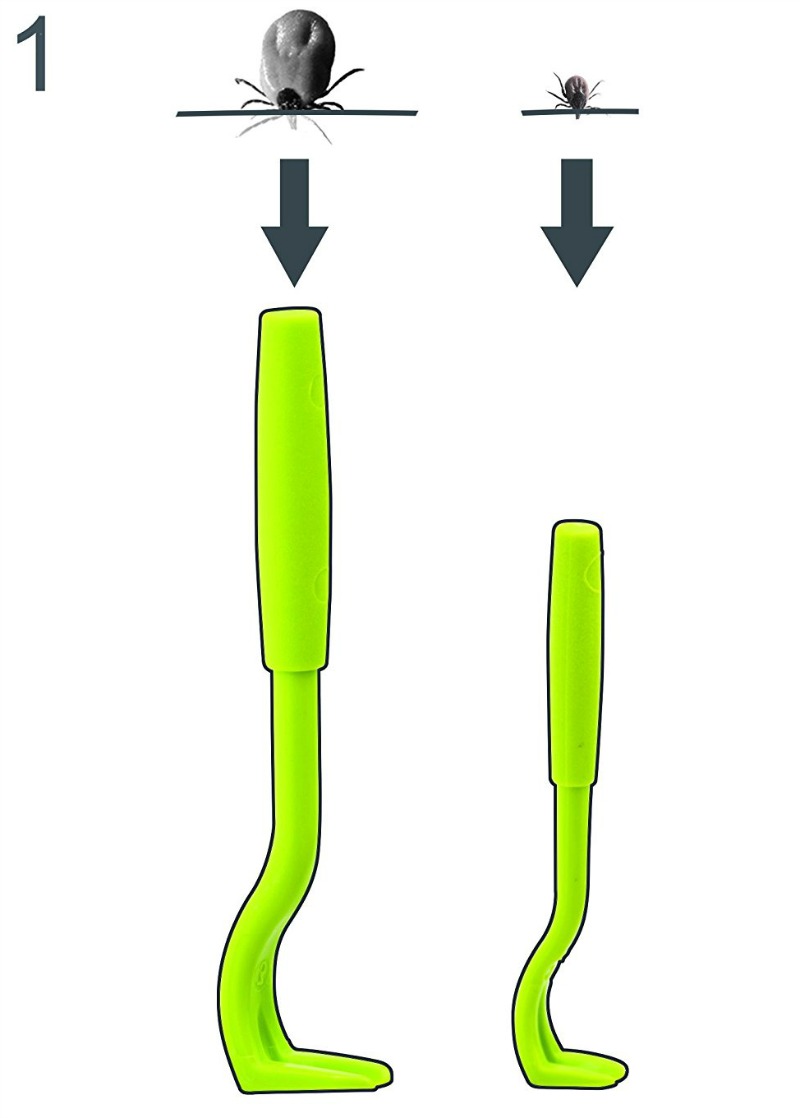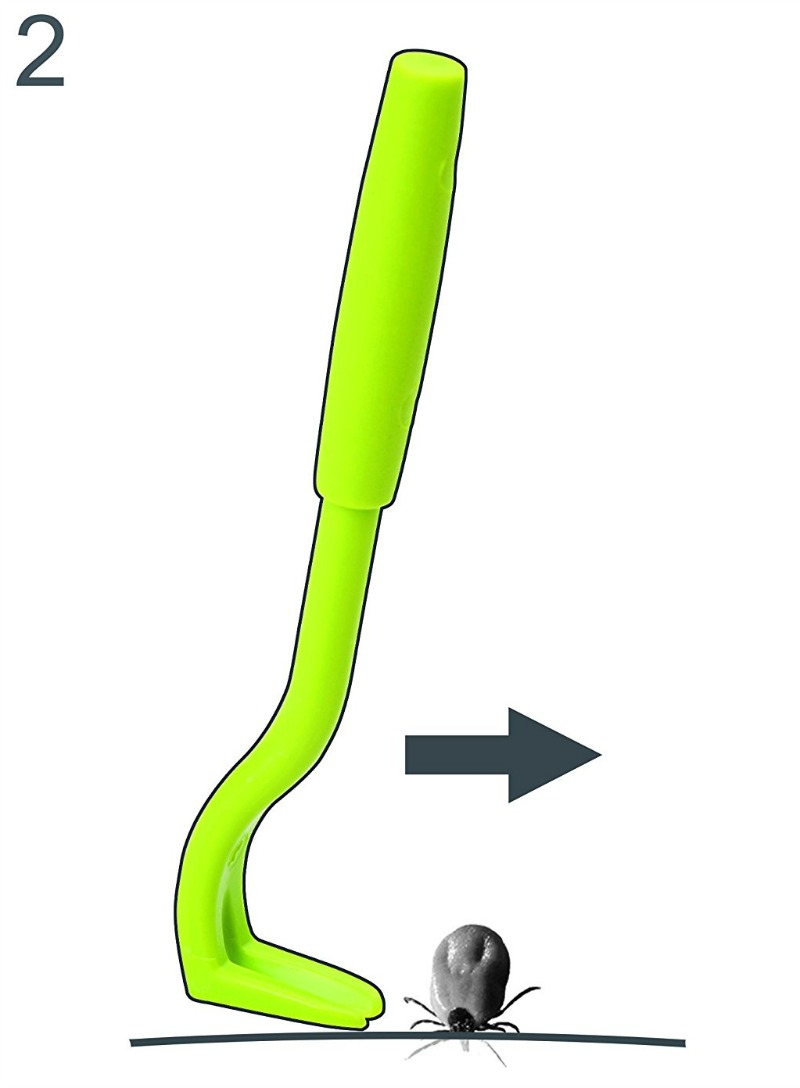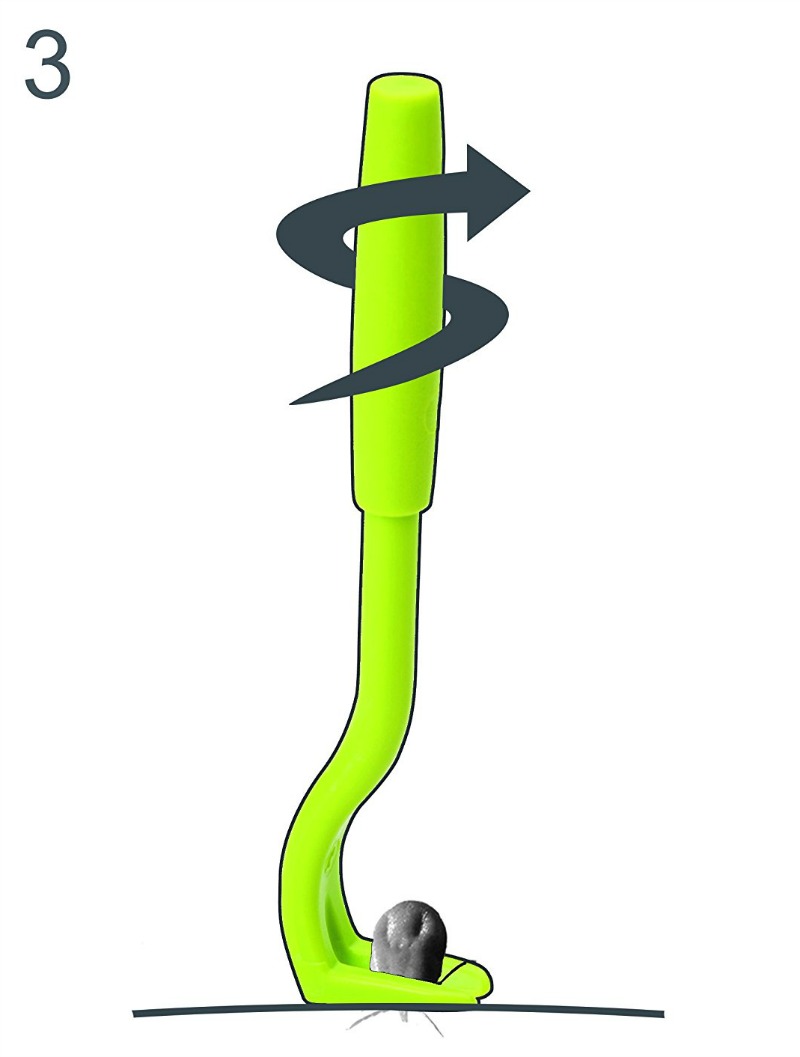Safe method to remove a tick without leaving the head stuck in the skin that works with small or large ticks and is easier than tweezers.

Each spring and summer, warmer weather and spending more time outside and camping outdoors increases the chances of exposure to nasty tick bites. The question is not “if” but “when” it will happen. And, when it inevitably does, how to remove a tick safely to minimize the chances of disease?
I have a friend who lives on a farm in Kentucky with his wife and five children. During tick season, he and his wife perform tick checks every night on all their children right before bathtime. They take ticks very seriously in their home because the Lyme disease carrying kind are very prevalent in their area.
It’s not just Lyme disease that is a potential risk either. The Journal of General Internal Medicine published an article by Susan Wolver, MD, and Diane Sun, MD, which identified a rising trend of red meat allergies from tick bites.
When one of my children was a fairly young baby and not even mobile yet, a tick lodged itself into the top of his head. Most likely, the tick dropped out of a tree onto his head, so don’t think your children are safe just because they aren’t hiking in the woods or walking in the grass!
If you discover that your child or pet has a tick that has lodged itself into the skin, here is the safest, easiest and quickest way to remove it.
How to Remove a Tick Safely and Quickly
The best way to remove ticks is using tweezers according to most authoritative sources. However, there is a new gadget called the tick twister remover that works even better.
My friend in Kentucky says that they used to use tweezers, but the tick twister is far superior and easier to use. It can be used to remove ticks from both pets and people.
Each tick twister tick removal set (it only costs about $6) has two removers inside: one large and one small. The different size is to allow for safe removal of both small and large ticks.
This ingenious device created by a veterinarian to safely remove ticks regardless of a person’s expertise has the following benefits:
- It is easier to use than tweezers especially for small ticks.
- It removes the tick without squeezing it, which greatly reduces the chances of disease transmission.
- It ensures the head and mouthparts of the tick are removed along with the body.
- It can be used for both large and small ticks.
Every home with children and/or pets should have one of these! It should also be included with camping equipment.
Safe Removal Steps. Better than Tweezers!
There are three steps for removing a tick using the tick twister.
First, you select which tick twister to use. If the tick is large, use the larger tick twister. If the tick is small, use the smaller one. Pretty simple!

Second, you grasp the tick between the head and body using the hook end of the tick twister. The picture below shows how to do it.

Third, simply twist the tick twister gently to easily and safely remove the entire tick out of the skin. That’s it!

After removing the tick, thoroughly clean the affected skin with alcohol. If there is any irritation, a dab of this herbal salve does wonders to quickly heal the skin.
Warning About some Tick Removal Recommendations
Some sources recommend pulling a tick straight out of the skin as the best method of removal.
This is very dangerous advice, because trying to pull a tick straight out will almost ALWAYS result in the head staying stuck in the skin. This is because ticks frequently lodge into the skin at an angle. They don’t usually burrow straight in perpendicular to the skin’s surface.
If you must use tweezers because you don’t have the tick twister remover available, be sure to pull the tick out at the same angle it went in.
This will give you the best shot at removing the head along with the body. In other words, grab the tick very firmly and close to the head as you can and pull out on a straight line but the same angle it burrowed in. I hope this makes sense.
It’s a little difficult to describe in words. This is the method taught to me by my Dad, who is a retired family doctor. Using this method, I’ve never left a tick’s head in the skin of any pet or person in over 40 years.
Of course, using the inexpensive tick twister is the best method of all. You don’t have to worry about angles – you simply twist the tick out of the skin!
How to Repel Ticks
This article describes the method for preparing an herbal yarrow tincture which is very effective at repelling ticks so you don’t have to remove them in the first place.
You ideally need to spray yourself every 2 hours or so.
Note that yarrow has been reputedly found by the US Army to be as effective as DEET in repelling ticks.








o.k. peeps ..I guarantee I have removed more ticks off of my body than everybody that has commented combined.(I own a tree service).Many animals have fight or flight as a survival technique. A snake or a raptor will puke out its last meal to aid a speedy escape. When you go tinkering around with a tick they dis engorge as much as they can so they can”run”….best thing to do is quickly grab it as close to your skin as possible …try not to squeeze the body but use a finger nail to lift it straight off and destroy the bugger.If it is very small use duct tape to lift it off.
I tried to post a quote from Dr. Jospeh Burruscano at the blog, with some info on how not to remove a tick, which includes the method that this post recommended. I am now on moderation. I am dissapointed in this. I would not have expected something like this from Sarah, who seems so committed to true health information. Dr. Burruscano has been one of the most respected Lyme doctors in the US. If the right information gets out, it will save lives.
The fact that you have been put on moderation is shocking to say the least. You have been respectful in every post and doing what you can to educate everybody in order to keep them from getting very ill. I had suffered with Lyme disease and coinfections for over a decade before even being diagnosed.
This erroneous way of tick removal posted by Sarah is indeed much worse than giving a baby soy milk and having all the vaccinations I’ve had as a child never made me as sick as Lyme and co.
I just don’t get it, Sarah, you research everything else thoroughly, but stop at 2 badly informed people for such a serious post. A bad diet would less harmful than Lyme. I hope you realize you may very well be responsible for someone getting Lyme and/or a coinfection if you don’t retract this post.
As many of you know, Lyme disease treatment has been a hot political issue for many years. Insurance companies carry big clout, and they don’t want any official recognition that Lyme and other tick borne diseases can be a chronic disease, because there are thousands of people suffering from chronic Lyme and other TBDs, and the insurance companies might have to help them. They have suppressed the facts about Lyme and associated diseases and applied political pressure, and as a result, state medical boards have hounded many Lyme-literate doctors and forced them to end their practices, or at least to stop treating Lyme patients long-term. I know of a doctor in my state who had to stop long-term antibiotic treatment and has moved to a neighboring state. He was the best Lyme doctor we had, possibly in the whole Southeast. Hundreds of his patients spoke on his behalf at his hearing, to no avail. This is simply persecution of doctors who are saving lives, so insurance companies can make huge profits.
Dr. Joseph Burruscano is one of these doctors. He is considered in the top group of Lyme doctors in the US, but has had to stop practicing due to this harassment. Here is a quote from one of his articles on Lyme treatment. It is talking about the criteria for treating patients who have had a deer tick bite recently, with no symptoms yet. Notice what he says about improper tick removal in #3:
*******************************************
APPENDIX
RATIONALE FOR TREATING TICK BITES
Prophylactic antibiotic treatment upon a known tick bite is recommended for those who fit the following
categories:
1. People at higher health risk bitten by an unknown type of tick or tick capable of transmitting Borrelia
burgdorferi, e.g., pregnant women, babies and young children, people with serious health problems,
and those who are immunodeficient.
2. Persons bitten in an area highly endemic for Lyme Borreliosis by an unidentified tick or tick capable of
transmitting B. burgdorferi.
3. Persons bitten by a tick capable of transmitting B. burgdorferi, where the tick is engorged, or the
attachment duration of the tick is greater than four hours, and/or the tick was improperly removed. This
means when the body of the tick is squeezed upon removal, irritated with toxic chemicals in an effort to
get it to back out, or disrupted in such a way that its contents were allowed to contact the bite wound.
Such practices increase the risk of disease transmission.
4. A patient, when bitten by a known tick, clearly requests oral prophylaxis and understands the risks.
This is a case-by-case decision.
**********************************
ILADS is a good organization that provides real information about Lyme (and associated diseases) treatment, testing, etc. as opposed to other organizations that kowtow to the insurance companies. They are highly respected in the Lyme disease community. Their site:
http://www.ilads.org/
Agree with so many who have posted above. This is a stupid practice designed to increase your chances of contracting Lyme and associated diseases. Spreading this sort of disinformation is irresponsible at best.
Do not do this. It increases your risk of contracting any diseases the tick might be carrying.
Sure, the tick will let go. But first it starts to suffocate, and when that happens, it often vomits. And when it vomits, it disgorges its stomach contents into its host (you or your pet), including all the pathogens it’s carrying. This increases the chances that you or your pet will become infected.
So don’t do it. Use needle-nosed tweezers or one of those tick removal spoon thingies. Grab it as close to the head as you can and draw it straight out. Even if you break the head off (not ideal), it’s better than having it barf into you. Be careful not to squeeze the abdomen, as this too can disgorge stomach contents.
This also applies to ketchup, peanut butter, bug spray (to an attached tick), Elmer’s Glue … just pull it off already. Don’t increase your risk of infection by making the silly thing hurl.
I too am disappointed that the initial post hasn’t come down or that Sarah hasn’t at least commented on it directly. It would certainly help if both sides could be represented, with one of the many posts from Judith included. Judith’s information makes excellent sense to me – and it’s extremly well explained. The loyal followers of the HHE site – of which I am one – deserve to be given all possible information so, as is so often said about other issues, e.g. vaccines, they can make their own decisions. It’s unfortunate that time pressures mean that many people only read the first article and don’t go onward to read the comments and only know of one point of view.
My 2 yr old woke up this morning with a tick and I remembered that an article was just posted on how to remove them, so I tried the soap method a few minutes ago before reading all the comments. It didn’t work. I still had to pull it out with tweezers.
The safest thing is to reach for the tweezers first.
I am shocked, disappointed and saddened that Sarah is sticking to it since she found a hospital that recommends the same thing. I suggested that she research the recommendations of those who research vector borne illnesses (should said esp. Lyme disease). …As one with Lyme disease I am disappointed and feel bad about those who will take this advice.
I, too, am heartsick over this. I am getting too stressed out, and I may have done all i can to help Sarah get the facts. I wrote to her directly and asked her to read just some of the links we have posted with tick facts, but she insists that this method is safe because many people have used it successfully. And there is the issue–you may get a tick off easily by irritating it or smothering it, applying heat or noxious substances, but that does not make it a safe practice. It is dangerous. The tick is more likely to transmit disease as it leaves. So you get an easy removal, and possibly a deadly disease. Not a good tradeoff.
I asked her to read just a few of our links. I don’t know if she will. I hope others will read the comments and learn safer methods, but I doubt it.
Feeling very upset, may not be back. Carry on, folks–please. I’ve put up more than enough reputable links to educate anyone.–Judith
The vast majority of doctors know little to nothing about these infections, or about tick biology.. You have to go to people who study ticks to get the facts. I’m not surprised to find that a hospital advocates an unsafe removal method. They are not tick experts, and they don’t know tick behavior, anatomy and physiology. That’s why I posted the links I did. Those sources know what they are talking about. A hospital does not, unless they have someone on staff who has made a special study of the subject.
I have been enjoying learning from Sarah. I thought she would be interested in the biological facts. I am surprised to see her response. As someone said, this is like saying that soy formula is great for babies, but it’s really more extreme, because soy formula is not going to give a baby a potentially deadly disease right away. Lyme and RMSF can kill fast, in some cases, and TBDs can create a lifetime of disability. This tick removal method increases the chances of it happening. It is simply a fact of biology, not a prejudice on our part. I’m very much pro-Sarah and her work! Just not this one post.
This saddens me, too. I’ve enjoyed this blog for some time, but, Sarah has lost a lot of credibility here, as far as I’m concerned.
For what it’s worth, my doctor’s office definitely recommends tweezers for tick removal.
I can’t believe that 110 people have shared this so far. Heart breaking. As someone with Lyme disease, the mere fact that so many people do not yet know how to properly remove a tick, and the dire consequences of doing it incorrectly as described in this post is a tragedy. It’s a societal problem that generally well informed people and PARENTS can be ignorant of these important facts.
If people would read most of the comments here, they would learn proper tick removal. But it certainly is a heartbreaking situation. I hope Sarah will read the comments and retract this post in her blog, and instead post the correct information.
Judith, thank you for caring enough about people to continue warning them over and over. As I was reading this article I was thinking “huh?” because I had heard that it was unsafe to cause a tick to back out. I hope Sarah removes this post soon!
I respect Sarah very much, and I am so grateful for all the important information she shares. This blog has enriched my life. I assume she has not seen our comments yet, but every time someone posts here that they are going to try this soap method, my heart breaks. I’ve known so many people through the Lyme groups who have spent years in hell with tick diseases, and I wonder how many readers of this blog are reading the post and not responding, but will try this method. Some of them are likely to get sick. Luckily, not every tick carries infection, but some carry more than one. Sigh.
I hope Sarah will read our comments soon! Does anyone know how to contact her directly and alert her? I wrote at her FB page.